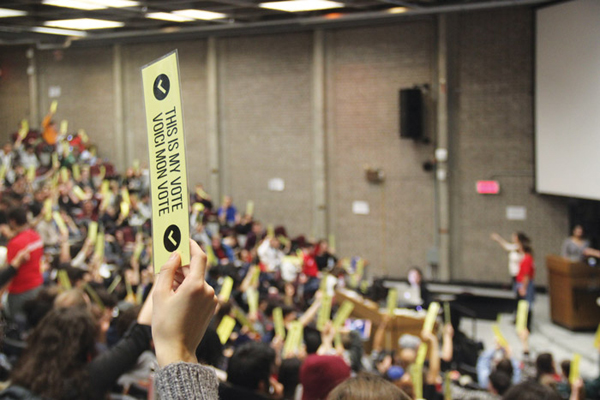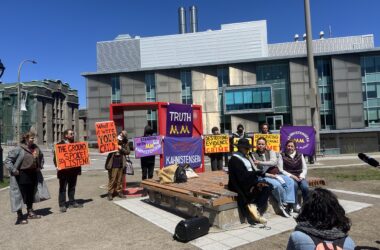Voting for the Students’ Society of McGill University (SSMU) 2018 Winter Election and Referendum closed on March 21 with a voter turnout of 32.8 per cent. Despite less than a third of all eligible SSMU members voting, this figure represents the highest voter turnout in the past 14 years.
7,100 of 21,636 eligible electors cast online ballots in the election—a far greater proportion than the 21.8 per cent turnout in Winter 2017, or the 17.5 per cent turnout in Winter 2016 ballots. The referendum questions, which students voted on alongside six SSMU executive positions, included one concerning SSMU’s policy on the implementation of a Fall reading week.
According to Matthew He, Chief Electoral Officer at Elections SSMU, this year’s relatively high voter turnout is likely due to the presence of the Fall reading week question. In an interview with The McGill Tribune, He interpreted a high level of ‘abstain’ votes on questions unrelated to the Fall reading week as evidence that many student voters were interested in only one question.
“While acknowledging [that this year’s election had] the highest turnout we’ve had in the last 15-plus years, we do have to realize that there are a substantial number of people who abstained in every single vote except the Fall reading week referendum,” He said. “I understand that what tends to happen when you combine the referendum with the candidates ballots [is that] people will go vote for the one issue that they are passionate about and abstain from all others because they are not informed enough.”
He also described the new strategies that Elections SSMU used to encourage people to vote, like distributing promotional material, tabling to answer questions concerning the voting process, and collecting feedback from SSMU members who did not vote.
“I sent out an email to those who had not voted by the [final] day of the elections,” He said. “The most common feedback I got was that they simply did not have enough information on the candidates or referendum. They didn’t know what they were voting for. A lot of the feedback was expressing disinterest in the elections.”
Most questions in the Winter Election, including the SSMU presidential ballot, had over 2,000 abstentions. Taking abstentions into account, the underlying voter turnout for executive positions was an average of 19.6 per cent, which is consistent with last year’s low turnout.
This apparent lack of student engagement is mirrored at the graduate level, where voter turnout and candidate nominations have consistently been even lower. In the last McGill Post-Graduate Students’ Society (PGSS) General Election, which closed on Apr. 1, only 755 members, or 9.8 per cent of the electorate, cast ballots. Moreover, three of the executive positions—Financial Affairs Officer, Internal Affairs Officer, and Membership Services Officer—featured no candidates, and will be voted on in a by-election opening on Apr. 28.
Tre Mansdoerfer, U2 Engineering and SSMU president-elect, identifies a culture of institutional disconnect as one of the potential reasons for voter apathy at McGill.
“For whatever reason, at McGill, there’s a disengagement with the school and a disdain between students and McGill University,” Mansdoerfer said. “I think it has to do with [the administration] and how they interact with students, [and] I think it has to do with the culture they created. For whatever reason, McGill has been founded upon a lack of pride in the school. A good chunk of people aren’t happy being at this school. They’re here for the prestige and not their own happiness.”
Voter apathy and low voter turnout are not problems unique to McGill. Other large research universities in Canada continue to struggle to get students to vote in elections and referenda. The general elections of the University of British Columbia’s student union, the Alma Mater Society (AMS), have voter turnout percentages similar to those at McGill University, with a 20.7 per cent turnout in 2017, and 12.5 per cent in 2016. In 2016, the University of Toronto held a referendum for a fee levy for the campus radio station, with a proposed fee increase from $4.85 to $12.85. The levy of nearly 200 per cent, which represented an increase of over 100,000 dollars in funding for the radio station carried with only 59 members voting.
Zak Vescera and Ryan Jones, student journalists at UBC, investigated the low voter turnout rates for The Ubyssey and found that politically apathetic students tended to fall into one of two categories. They explained the results of their surveys in an email statement to the Tribune.
“In our reporting, I’d say we found two primary types of ‘apathetic’ students,” Vescera and Jones wrote to the Tribune. “The first group simply didn’t know what the AMS does or how it benefits them [….] Others knew what the AMS does, but didn’t feel like the result of an election would impact them in any concrete way. These students were often part of demographics that they felt the AMS doesn’t advocate for enough [….] Students directly involved in ‘campus life’ almost always vote, but [students who are less involved] told us they felt left out of the whole thing.”
These shared difficulties in engaging large student bodies may also stem from characteristics unique to Canadian student unions. According to Alex Usher, president of Higher Education Strategy Associates, Canadian universities tend to be more complex and more concerned with running on-campus businesses like bars and restaurants than their counterparts in the United Kingdom, which are smaller and tend to focus on advocacy and academic affairs.
“In the UK [and other countries], the student unions are very focused on being a part of the quality assurance process, [….] and somehow that’s never caught on [in Canada,]” Usher said. “Although we have lots of students who are interested in political issues, we tend to define the political issues as being dollars and cents issues, and not [questions pertaining to academic quality and relevance].”
However, metrics like election turnout may not necessarily be the best way to measure a student society’s impact, according to Usher.
“Voting is one measure of engagement, but another measure is simply how many people are involved in the governance structure,” Usher said. “If the central student union is engaging everyone in the faculties and department and [making suggestions and offering support in academic affairs,] I think doing that stuff increases the quality of the engagement rather than the quantity [….] At the end of the day, you’re doing something that matters more to students.”
A number of changes have been proposed by incoming SSMU executives to increase member engagement with the organization. Outlining his plans for next year, Mansdoerfer discussed his intention to refocus SSMU’s efforts on projects that matter to students.
“It really feels like people involved in SSMU are dissociated from what students really want to see,” Mansdoerfer said. “It’s really easy to get focused on your personal projects, and it’s easy to miss out on what really matters [.…] I really hope that I can bring the structural and institutional change that has to happen for good leadership.”








